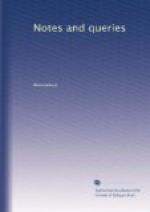—— “si ode squilla
di lontano
Che paja ’l giorno pianger che si
muore.”
And it is worthy of notice that this passage corresponds with the first line of Giannini’s translation of the Elegy, as quoted by J.F.M.:—
“Piange la squilla ’l giorno, che si muore.”
I must add, however, that long before Lord Byron thought of writing Don Juan, Mr. Cary, in his excellent translation of the Italian poet, had noticed this plagiarism in Gray; and what is more, had shown that the principal thought, the “giorno che si muore,” was borrowed by Dante from Statius’s
“Jam moriente die.”
HENRY H. BREEN.
St. Lucia, West Indies, Nov. 1850.
[The preceding communication was accompanied by several others, and by the following gratifying letter, which we print as a fresh proof that our paper is fulfilling the object for which it was instituted, namely, that of promoting literary intercourse between men of letters throughout the world and that it is as favourably received by our fellow countrymen abroad, as it has been by those who are enabled to receive it wet from the press:—
“Owing to the difficulty of procuring the early numbers of ’NOTES AND QUERIES,’ especially at this distance from Britain, I have been compelled to wait for its publication in a collected form. I am now in possession of the first volume, and beg leave to offer you a few Notes which have occurred to me on perusing its contents. I am fully sensible of the disadvantage of corresponding with you from so remote a corner of the globe, and am prepared to find some of my remarks anticipated by other correspondents nearer home; but having deeply suffered from the literary isolation consequent upon a residence of twenty-one years in this country, I shall gladly submit to any disadvantage which shall not involve a total exclusion from the means of inter-communication so opportunely afforded by your excellent periodical.
“HENRY H. BREEN.”]
* * * * *
THE NINEVEH MONUMENTS AND MILTON’S NATIVITY ODE ILLUSTRATED FROM LUCIAN.
Layard in his Nineveh, vol. ii., p. 471., in his description of “the sacred emblems carried by the priests,” says, they are principally the fruit or cone of the pine.
“... and the square
utensil which, as I have already remarked, appears
to have been of embossed or
engraved metal, or of metal carved to
represent wicker work, or
sometimes actually of wicker work.”
He adds, that M. Lajard “has shown the connection between the cone of the cypress and the worship of Venus in the religious systems of the East;” that it has been suggested that “the square vessel held the holy water,” that, “however this may be, it is evident from their constant occurrence on Assyrian monuments, that they were very important objects in religious ceremonies. Any attempt to explain their use and their typical {36} meaning, can at present be little better than ingenious speculation.”




